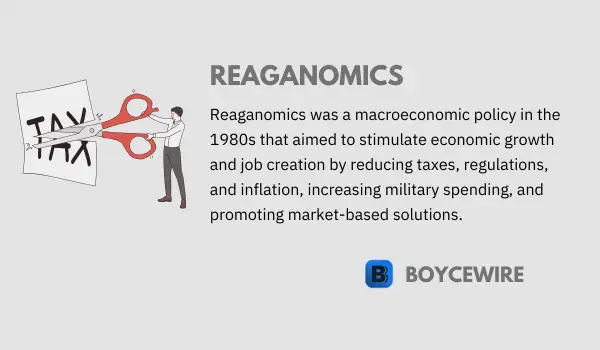Table of Contents ![]()
Reaganomics: Definition, Effects, Pros & Cons

What is Reaganomics?
Reaganomics refers to the economic policies implemented during the presidency of Ronald Reagan in the United States from 1981 to 1989. Reaganomics was based on supply-side economics, which emphasized the importance of reducing government regulation and taxes to promote economic growth. The policies were named after President Reagan who championed their implementation.
Reaganomics was characterized by four main policies: tax cuts, deregulation, reduced government spending, and a tight monetary policy. The idea behind these policies was to encourage investment and entrepreneurship, which would in turn create jobs and stimulate economic growth. The tax cuts were intended to provide individuals and businesses with more disposable income, which they could then spend or invest in the economy.
Deregulation was another key component of Reaganomics. The idea behind this policy was to remove government regulations that were seen as overly burdensome to businesses. This was done to encourage competition and innovation in the private sector. The reduction in government spending was aimed at reducing the federal deficit and the national debt.
Finally, the tight monetary policy was designed to control inflation by restricting the money supply. This policy was intended to promote economic stability and prevent inflation from spiraling out of control.
Reaganomics was widely debated at the time of its implementation and remains controversial today. Critics argue that the policies benefited the wealthy at the expense of the poor and that they led to an increase in income inequality. Supporters, on the other hand, argue that the policies spurred economic growth and created jobs.
Overall, Reaganomics had a significant impact on the U.S. economy and continues to be a topic of debate among economists and policymakers. While some of the policies have been modified or reversed over time, the underlying principles of supply-side economics continue to influence economic policy in the United States and around the world.
Key Points
- Reaganomics focused on reducing taxes, especially for the wealthy, in the belief that this would stimulate economic growth and job creation.
- The policy also involved reducing regulations on businesses, with the belief that this would encourage entrepreneurship and investment.
- It also involved significant increases in military spending, which had the effect of boosting the economy and creating jobs.
- Reaganomics embraced a monetarist approach to economic policy, which emphasized controlling inflation by limiting the growth of the money supply.
History of Reaganomics
The history of Reaganomics began in the early 1980s when Ronald Reagan was elected President of the United States. Prior to his election, the country was facing high unemployment, high inflation, and slow economic growth. Reagan believed that the economy could be stimulated by reducing taxes and regulations, which would encourage business investment and economic growth.
In 1981, Reagan signed the Economic Recovery Tax Act (ERTA), which included a series of tax cuts for individuals and businesses. The ERTA also included provisions to accelerate depreciation schedules for businesses and increase the exemption levels for the estate tax. These tax cuts were designed to encourage investment and stimulate economic growth.
In addition to the tax cuts, Reagan also pursued a policy of deregulation. He believed that many government regulations were stifling economic growth by creating unnecessary barriers to business activity. As a result, his administration worked to reduce regulations across a variety of industries, including energy, transportation, and telecommunications.
Reagan also pursued a policy of reducing government spending, which he believed was necessary to reduce the federal deficit and control inflation. He implemented spending cuts in a number of areas, including social welfare programs and military spending.
Finally, Reagan implemented a tight monetary policy to control inflation. The Federal Reserve raised interest rates to reduce the growth of the money supply and curb inflation. This policy was controversial, as it led to a recession in the early 1980s, but it ultimately helped to bring down inflation and stabilize the economy.
Overall, Reaganomics was successful in reducing inflation, stimulating economic growth, and creating jobs. However, it also contributed to a significant increase in the national debt and income inequality. Despite its flaws, Reaganomics remains a major influence on economic policy in the United States and around the world.
Effects of Reaganomics
The effects of Reaganomics, which refers to the economic policies implemented during the presidency of Ronald Reagan from 1981 to 1989, are still debated today. While the policies were intended to stimulate economic growth, reduce inflation, and create jobs, their impact on the economy and society was complex and multifaceted.
One of the most significant effects of Reaganomics was a period of sustained economic growth. The tax cuts and deregulation policies helped to spur business investment and entrepreneurship, which in turn created jobs and increased economic activity. From 1982 to 1989, the U.S. economy grew at an average annual rate of 4.4%, one of the strongest periods of economic growth in U.S. history.
However, the benefits of this economic growth were not evenly distributed. Income inequality increased significantly during the Reagan years, as the wealthiest Americans benefited the most from the tax cuts and economic policies. The poverty rate also increased, particularly among children and minority groups.
Reaganomics also had a significant impact on the federal deficit and the national debt. The tax cuts and increased military spending contributed to a significant increase in the federal deficit, which reached a peak of $221 billion in 1986. This, in turn, led to a significant increase in the national debt, which doubled during the Reagan presidency, from $994 billion in 1981 to $2.1 trillion in 1989.
The deregulation policies also had unintended consequences. The savings and loan industry was deregulated, which led to a wave of failures and required a taxpayer-funded bailout. The deregulation of the telecommunications industry, while promoting competition and innovation, also contributed to media consolidation and a reduction in diversity of viewpoints.
In addition, the tight monetary policy led to a recession in the early 1980s, which contributed to high unemployment and economic hardship for many Americans.
Advantages of Reaganomics
Reaganomics, the economic policies implemented during the presidency of Ronald Reagan in the 1980s, has been a subject of debate and criticism over the years. However, there are also many proponents of these policies, who believe that they were beneficial for the economy. Below are some of the advantages of Reaganomics:
1. Economic growth
Reaganomics focused on stimulating economic growth through lower tax rates, decreased regulation, and increased government spending on defense. This led to a period of sustained economic expansion, with the GDP growing at an annual rate of 3.4% from 1983 to 1989.
2. Lower inflation
During the 1970s, the US experienced high levels of inflation, which eroded the purchasing power of the dollar. Reaganomics aimed to reduce inflation by limiting the growth of the money supply, which helped to stabilize prices.
3. Increased employment
The policies of Reaganomics led to increased employment, with the unemployment rate falling from 10.8% in 1982 to 5.3% in 1989. This was largely due to the growth of the service sector, which was supported by the government’s policies.
4. Lower tax rates
Reaganomics lowered tax rates for both individuals and corporations, which led to increased investment and economic growth. Lower taxes also helped to incentivize entrepreneurship and small business growth.
5. Increased investment
The policies of Reaganomics created an environment that was conducive to investment, with lower taxes and decreased regulation. This led to increased investment in businesses and industries, which helped to fuel economic growth.
6. Increased military spending
Reaganomics also increased military spending, which helped to strengthen the country’s defense capabilities. This increased spending also helped to create jobs in the defense industry.
7. Improved trade
Reaganomics supported free trade policies, which helped to improve trade relations with other countries. This helped to increase exports and imports, which contributed to economic growth.
Disadvantages of Reaganomics
Reaganomics refers to the economic policies implemented by the United States government under President Ronald Reagan in the 1980s. While it has been praised by some for its focus on free-market principles and deregulation, there are also many criticisms of the policy. Below are some of the disadvantages of Reaganomics:
1. Income inequality
Reaganomics is often criticized for exacerbating income inequality. While the policies did result in economic growth, much of the gains went to the wealthiest Americans. The top 1% of earners saw their income increase by over 100% during the Reagan era, while the bottom 20% of earners saw their income remain stagnant or even decline.
2. Job losses
While Reaganomics did lead to economic growth, it also resulted in significant job losses in certain industries. The manufacturing sector was particularly hard hit, as the government’s policies favored the service and financial sectors over manufacturing.
3. Increased national debt
Reaganomics relied heavily on tax cuts and increased defense spending, which led to a ballooning of the national debt. By the end of Reagan’s second term, the national debt had tripled from its level in 1980.
4. Deregulation
One of the key tenets of Reaganomics was deregulation, which led to a number of negative consequences. The deregulation of the savings and loan industry, for example, contributed to the savings and loan crisis of the late 1980s.
5. Environmental damage
Reaganomics also led to a relaxation of environmental regulations, which resulted in significant damage to the environment. The government’s policies on mining, drilling, and other extractive industries were particularly harmful.
6. Lack of investment in social programs
The government’s focus on tax cuts and defense spending meant that there was less money available for social programs like education and healthcare. This lack of investment in social programs has had long-lasting consequences, particularly for low-income Americans.
7. Failure to address poverty
Despite the economic growth that occurred during the Reagan era, poverty rates remained stubbornly high. The government’s policies did little to address the underlying causes of poverty, such as lack of access to education and healthcare.
FAQs
Reaganomics, also known as supply-side economics, was an economic policy implemented by the US government during the 1980s under President Ronald Reagan.
Reaganomics focused on reducing taxes, especially for the wealthy, reducing regulations on businesses, increasing military spending, and controlling inflation through a monetarist approach.
The goals of Reaganomics were to stimulate economic growth, create jobs, and control inflation.
Reaganomics is a controversial topic, with opinions on its success or failure varying widely. Supporters argue that it led to strong economic growth and job creation, while critics argue that it contributed to income inequality, the growth of the national debt, and had limited benefits for middle and working-class Americans.
Reaganomics involved significant tax cuts, especially for the wealthy, with the belief that this would stimulate economic growth and job creation.
About Paul
Paul Boyce is an economics editor with over 10 years experience in the industry. Currently working as a consultant within the financial services sector, Paul is the CEO and chief editor of BoyceWire. He has written publications for FEE, the Mises Institute, and many others.

Further Reading
 Debt to Equity Ratio - The debt-to-equity ratio is a financial metric that compares a company's total debt to its total equity to assess its…
Debt to Equity Ratio - The debt-to-equity ratio is a financial metric that compares a company's total debt to its total equity to assess its…  Factors of Production: Definition, 4 Factors & Examples - The factors of production are all the various elements that are required to come together to create a good.
Factors of Production: Definition, 4 Factors & Examples - The factors of production are all the various elements that are required to come together to create a good.  Corporate Finance - Corporate finance is the field of finance that deals with the financial decisions and activities of corporations, including capital structure,…
Corporate Finance - Corporate finance is the field of finance that deals with the financial decisions and activities of corporations, including capital structure,… 
